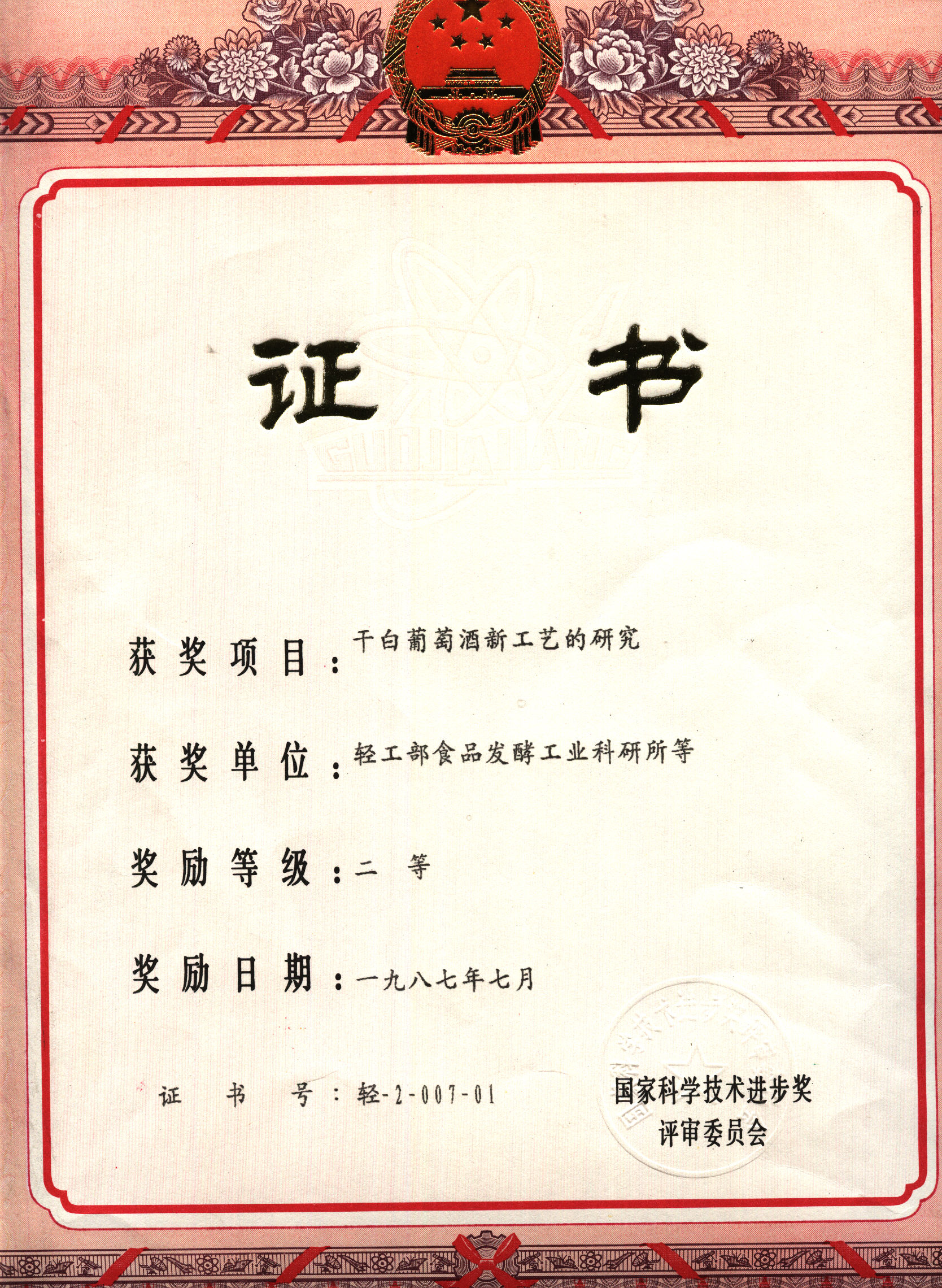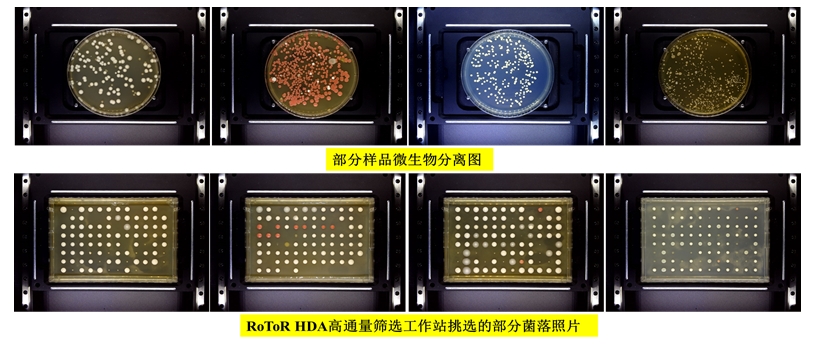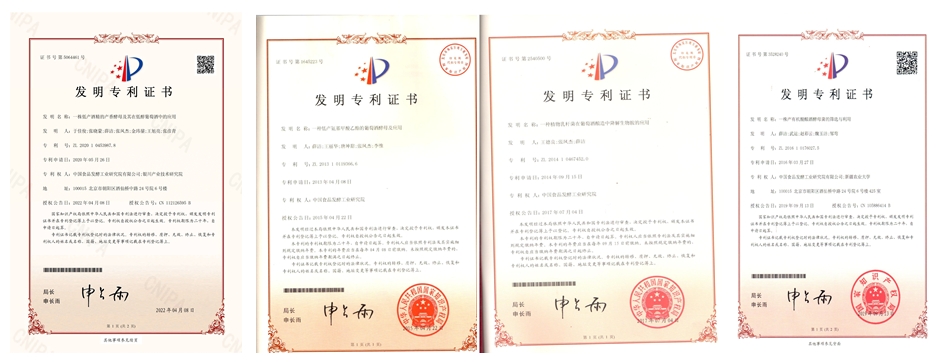Field introduction
China National Research Institute of Food and Fermentation Industries has been engaged in research and development in the fields of wine and fruit wine since its establishment in 1955. Over the years, it has successfully completed a series of national research projects, including studies on artificial aging of wine, wine stability, breeding of wine grape varieties, sensory evaluation of wine, high-quality brandy research, new techniques for dry white wine production, and industrial trials of new wine production technologies. Notably, the project on artificial aging of wine received the National Science and Technology Progress Third Prize, while the research on new techniques for dry white wine was honored with the National Science and Technology Progress Second Prize. These achievements have laid a solid foundation for the development and growth of China’s wine industry.


In recent years, the China National Research Institute of Food and Fermentation Industries has undertaken extensive research and production work in the fields of wine and fruit wine. The institute has been involved in several significant national research projects, including Key Technology Research for Grape Wine Industry in the Eastern Foot of Helan Mountain, Ningxia (Project ID: 2019YFD1002500), Efficient and Safe Manufacturing Technology Research for Brewing Raw Materials (National "863" Program Project, Project ID: 2013AA102108), Research and Development of Key Technologies for Controlling and Reducing Potential Harmful Substances in Beverage Wines (Ministry of Science and Technology Institute Fund Project, ID: 2014EG111217), Safety Control Mechanism Research on Ethyl Carbamate in Xinjiang Local Grape Wine (National Natural Science Foundation of China, Project ID: 31360406), Green High-Value Technology Research and Application in the Whole Grape Industry Chain (Beijing Rural Revitalization, Project ID: Z191100004019018), Research on Quality and Safety Control Technology for Xinjiang Characteristic Winery Grape Wine (Major Science and Technology Project of Xinjiang Autonomous Region, Project ID: 2017A01001). The institute has made significant contributions in various aspects, including wine styles, health benefits, safety evaluation, and microbial selection. Notably, their research and development efforts have led to innovative technological achievements, such as using isotope analysis to identify the origin of grape wine and applying microbial antimicrobial agents. These advancements have filled gaps in domestic knowledge and reached international standards, resulting in one provincial-level scientific and technological achievement award and over ten authorized patents.
To promote international exchange and industry development in the fields of wine and fruit wine, the Institute has undertaken the Sino-Czech government exchange project "Research on wine quality and safety control technology", the Sino-Romanian government exchange project "Research on microbial diversity and bioactive substances in microbial brewing", and the University of Adelaide, Australia; Wine Research Institute of Australia and Wine Branch of China Wine Association jointly held the International Wine Technology Summit in 2013 and 2015, and cooperated with China Fruit Wine Industry Science and Technology Innovation Strategic Alliance to hold the third China Fruit Wine Industry Science and Technology Innovation Development Summit and other forums. The first Xinjiang Wine Competition, the first "My Favorite fruit wine" national selection finals and other selection activities have great influence at home and abroad.
In terms of enterprise collaboration, the institute has collected and organized microbial resources from grape wine production areas in Xinjiang, Ningxia, and Changli, Hebei, cooperated with the establishment of domestic well-known enterprises microbial bank and screened functional microbial strains suitable for wine styles in the production area. As a result, the institute have successfully developed a range of new fruit wine products, including blueberry wine, rose wine, goji berry wine, pineapple wine, and kiwi wine, achieving positive economic outcomes.
Main research topics
⑴Key technologies for microbial diversity analysis and characteristic microbial screening in wine regions:
Based on high-throughput analysis technology, microbial diversity in different wine regions was analyzed to reveal the regulatory mechanism between wine-making microorganisms and quality at gene level, transcription level and metabolism level, and to screen local excellent microorganisms.



(2) Key technologies of wine quality improvement based on flavor omics:
To study the composition, evolution and interaction of microbial flora in the fermentation process, reveal the relationship between local microbial diversity and wine quality style and quality, and establish microbial targeted regulation technology.

(3)Wine origin-identification and age-authentication technology:
The content and distribution of deuterium, oxygen and carbon isotopes in wine grapes and wines were analyzed by SNIF-NMR and IRMS, and an isotope information database was established for wines of different production areas, vintages and varieties in China, on the basis of which a method for the identification of vintage wines and wines of different production areas was proposed.

(4) Key technologies for wine quality and safety control:
In order to improve the safety of wine, the metabolites of yeast and lactic acid bacteria, ethyl carbamate and bioamines were studied by metabonomics.

(5) Development of new wine and fruit wine products

Project list
1. National Key R & D Program Project: Research and Demonstration of Key Technology of Wine Industry at the eastern foot of Helan Mountain, Ningxia, 2019YFD1002500 2019/05-2022/12.
2. National "863" Program project, Grape raw material Evaluation System Research and development, 2013AA102018, 2013/01-2017/12.
3. National Natural Science Foundation of China, Study on the safety control mechanism of ethyl carbamate in Xinjiang Real Estate Wine, 31360406, 2014/01-2017/12.
4. Institute Fund Project of Ministry of Science and Technology, Research and Development of Key technologies for Controlling and Reducing Potential harmful Substances in beverage and wine Manufacturing, 2014EG111217, 2014/01-2015/12.
5. Beijing Science and Technology Support rural revitalization, grape whole industry chain green high-value technology research and application and scientific and technological assistance, Z191100004019018, 2019/01-2021/12.
6. Beijing Science and Technology Nova Project, Research on the inhibition mechanism of Bacillus amyloliquefaciens on grape fungal diseases, Z181100006218004, 2018/01-2020/12.
7. Research on histidine and tyrosine decarboxylase gene polymorphism and WMAADs database in wine making, Beijing Nature Foundation Project, 5132029, 2013/01-2014/12.
8. Key R&D Project of Xinjiang Uygur Autonomous Region, Research on Key Technologies of Wine Quality and Safety Nutrition and Health, 2022A02002, 2022/01-2025/12.
9. Major Science and Technology Project of Xinjiang Uygur Autonomous Region, Research on Wine Quality and Safety Control Technology of Xinjiang Characteristic Wineries, 2017A01001, 2017/10-2020.12
10. Science and Technology Project of Hebei Province, Mechanized Field management of wine Grapes and application technology of microbial antibacterial agents, 16222901D, 2016/05-2019/05.
11. Xinjiang Uygur Autonomous Region Science and Technology Program Project, Research on Microbial selection and Control of Harmful Microorganisms in Xinjiang Real Estate Wine Making, 201431113, 2014/01-2016/12.
12. Sino-romanian Government Exchange Project, Study on Microbial Diversity and Bioactive Substances in Wine Making, 2018/03-2020/03.
13. Inter-governmental Exchange Project between China and Uzbekistan, Research on Breeding of Fine Lactic acid Bacteria and its application in Traditional Fermented Food, CU02-17, 2017/01-2018/12.
14. Sino-romanian Inter-governmental Exchange Project, Study on Control and Utilization of Lactic acid Bacteria in Wine Making, 2016/09-2018/09.
15. Sino-czech Inter-Government Exchange Project, Research on New Technology of Wine Quality and Safety Control, 40-18, 2012/01-2014/12.

